| Author |
Message |
    
john fuller
Member
Username: scooter
Post Number: 7
Registered: 07-2011
| | Posted on Sunday, March 25, 2012 - 01:48 am: | 




|
Hi All
Im wondering if any one can help. I need to know the position of the timing shaft lobe in relation to the flywheel at top dead center as per pic 1.
Position of the magneto positioning pin on the magneto. pic 2 There are 3 screws so it could go three ways ?
Cheers John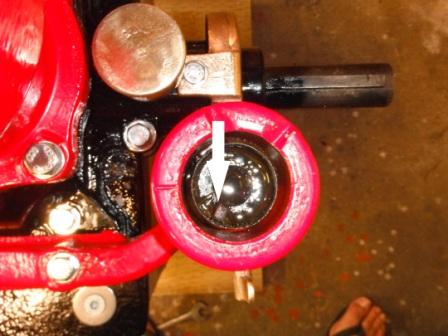 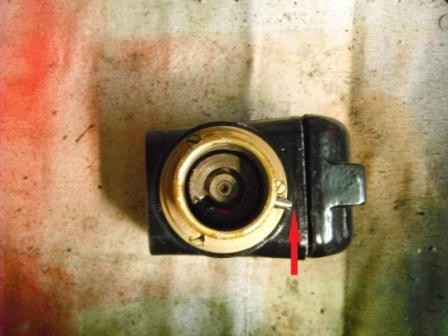 |
    
john fuller
Member
Username: scooter
Post Number: 8
Registered: 07-2011
| | Posted on Sunday, March 25, 2012 - 01:53 am: | 




|
Hi
Sorry, forgot to mention its a Blaxland super pup.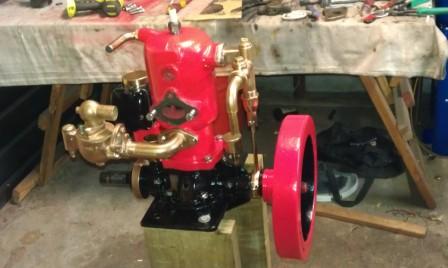 |
    
Todd Vidgen
Senior Member
Username: todd_vidgen
Post Number: 225
Registered: 03-2008
| | Posted on Sunday, March 25, 2012 - 04:47 pm: | 




|
The pin in the magneto drive assembly lines up with
the fine groove you may have to take the drive off
the motor to reset it
The other two slots are to take the pin on the magneto and locate it in either the forward or reverse running positions. But !!! ,being a super pup, if you have the right maggy ,you should be able to "bounce" start in either direction without
moving the maggy.
Todd |
    
quinton wilkinson
Senior Member
Username: qwilkin
Post Number: 60
Registered: 08-2009
| | Posted on Sunday, March 25, 2012 - 05:11 pm: | 




|
Todd Quinton here how do I get the wurths oil from you
Quinton |
    
john fuller
Member
Username: scooter
Post Number: 10
Registered: 07-2011
| | Posted on Saturday, May 05, 2012 - 09:21 pm: | 




|
Hi
Could anyone help with my magy, I cant remember where the stop button goes, attached is a picture, And also what would be the timing before TDC,
Thanks Todd for your help on my last question, Cheers All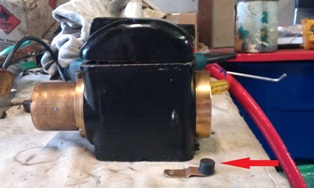 |
    
Todd Vidgen
Senior Member
Username: todd_vidgen
Post Number: 226
Registered: 03-2008
| | Posted on Sunday, May 06, 2012 - 05:40 pm: | 




|
directly above the black knob of the earth button
(stop switch)in your pic,there looks to be a black
plug lead and blue boot,the earth tag mounts on
there with a large head slotted machine screw.
The plug lead is supposed to attach to the copper
contact tag inside the black cap via a hole located
on the opposite side of the squared bulge on the cap
Inside the cap ,on the copper contact, you will find a small slotted screw with a pointed end,
remove the screw,inert the plug lead to the full depth of the hole,screw the screw back in making sure you have transfixed the wire core of the lead.
Todd. |
    
john fuller
Member
Username: scooter
Post Number: 11
Registered: 07-2011
| | Posted on Sunday, May 06, 2012 - 07:55 pm: | 




|
Hi
Thanks Todd, got it, i think. Any idea of timing. Cheers. |
    
Todd Vidgen
Senior Member
Username: todd_vidgen
Post Number: 227
Registered: 03-2008
| | Posted on Tuesday, May 08, 2012 - 06:30 am: | 




|
Same as all the other Blaxlands 5/16ths btdc vertically measured off the piston through the
plug hole |
    
quinton wilkinson
Senior Member
Username: qwilkin
Post Number: 64
Registered: 08-2009
| | Posted on Saturday, May 12, 2012 - 08:27 pm: | 




|
just bought a blaxland twin engine on ebay complete but in bits and been stored for years thought it would be a good winter project . Maggy is siezed, as are most of the bolts on the exhaust manifold everything else moves . Can anyone advise of bolt types ( witworth etc etc ) so I can buy some taps and dies to drill out the stuck ones also how do I free up the mag shaft and whats good to treat the inside of the barrels Water ways ) lots of rough dust coming out ???????????? Thanks Quinton |
    
john fuller
Member
Username: scooter
Post Number: 12
Registered: 07-2011
| | Posted on Monday, May 14, 2012 - 02:06 am: | 




|
Hi all
I hope this method of rust removal helps. this will remove all the rust from inside your water jackets Quinton |
    
john fuller
Member
Username: scooter
Post Number: 13
Registered: 07-2011
| | Posted on Monday, May 14, 2012 - 02:35 am: | 




|
Hi All
If you cant open the last file. Here it is
RUST REMOVAL
Rust can be safely removed off of STEEL parts by converting the rust itself, i.e. FeO2 and Fe2O3. Rust, hydrated iron, can be chemically "reduced", that means converted from a bonded molecule to a simple molecular Fe with free disassociated floating anions, by attacking the rust molecule with a charged molecule of something that likes bonding better than Fe. For this case Zinc works great.
How is this done, chemical reactions of this nature generally work faster with higher temperatures, a fluid bath is needed to better transport the replacement molecule to target areas. The Zinc must be turned into molecular Zinc and electrically charged to go after the rust and replace the Fe molecule with itself.
Now that is the theory so how do we get there?? Iron is pretty much impervious to alkaline solutions but dissolves in most acids. Zinc will dissolve in just about anything. We make up a solution of lye ( Caustic soda) and water at the ratio such that the water will boil at approximately 132 Deg c, well above the normal 100 Deg C. (50/ 50)Toss in some Zinc, preferably Zinc Oxide or just dirty Zinc. The Zn dissolves into the NaOh (lye) and leaves the Zn now charged positive. Since Zinc likes to bond to things better than Iron (Fe) the Zn+ molecule attacks the rust and takes the Iron molecule off and bonds itself to the Oxygen molecules that made up the rust. BUT in doing so it winds up floating in the solution. The result, the rust gets stripped off the Iron part, the Iron itself is untouched. This type of process has absolutely no bad effects to the original part just to the rust on the part. If you were to try an acid dip it would attack the base metal itself, the iron part.
The next trick in using this is as follows;
Hang the part on a piece of steel wire in the solution so you can pull it out from time to time and check it. I use safety wire for bolt heads. When the parts are done rinse them under lots of COLD running water. Next I immediately drop the parts into a solution of oily gasoline or thoroughly spray down with WD-40 to displace any water on the surface, sometimes then heat the part on a tin can lid (lid from the coffee can) to warm the part and drive off any remaining water in the pours of the metal, helps drive the oil into the surface as a preservative effect.
Cool trick of this process is that the lye being alkaline it treats the micro surface of the part and inhibits rust formation on a raw metal surface. If you try to acid dip a part it will always leave micro deposits of acid in the pours of the metal and it will re-rust in a matter of days. In an alkaline process this will never happen. If you see a gray smut form on the surface that is the carbon found in steel, part of the manufacturing process to make steel out of iron. Carbon is inert to these solutions so when the rust is dissolved into the solution it leaves behind the contained carbon. Just wash if off, I often use a tooth brush. |
    
Mark S
Senior Member
Username: marks
Post Number: 140
Registered: 03-2002
| | Posted on Monday, May 14, 2012 - 05:05 pm: | 




|
Thanks John,
That's very neat and something I hadn't heard of before. The chemistry seems right.
One thing is that reduction methods, generally, will not treat the chloride (salt) contamination. The only ways I know of doing this are heat and long term electrolysis. There are others but they are not suitable for simple/backyard setups.
Cheers,
Mark S. |
    
john fuller
Member
Username: scooter
Post Number: 14
Registered: 07-2011
| | Posted on Tuesday, May 15, 2012 - 05:03 am: | 




|
Hi mark
Mate this process works like nothing i have ever seen, removes everything, and im not joking, my super pup came up better than i expected inside and out, takes a bit of time and zinc but its worth it, when the process starts to slow down, you change the lye and zinc and off she goes again, it can get very reactive, so watch out, cool. i have a cut off 44 gallon drum that i use, go down to the local slip way and scab up some zinc, easy peazy, Cheers
Regards
Scooter 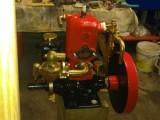 |
    
quinton wilkinson
Senior Member
Username: qwilkin
Post Number: 66
Registered: 08-2009
| | Posted on Tuesday, May 15, 2012 - 05:24 am: | 




|
Is this method okay to clean the inside of the water channels in Blaxland twin , I want to treat the inside of the water ways as lots of rust pieces keep comming out every time I turn the barrels over. Havent got much space and area to make a bath though would need to get someone to do it
Quinton |
    
john fuller
Member
Username: scooter
Post Number: 15
Registered: 07-2011
| | Posted on Tuesday, May 15, 2012 - 06:50 am: | 




|
Hi Quinton
This method is perfect for the water channels, I removed the welsh plugs and filled the water channels with small pieces of zinc, Its very surprising the amount of rust that is removed, I could not fit the blade of a screwdriver into the gap in the water jacket, now it about 1/2 an inch. clean as a whistle, i have also filled the back of my new brass welsh plugs with zinc to stop further corrosion in its new life. |
    
quinton wilkinson
Senior Member
Username: qwilkin
Post Number: 67
Registered: 08-2009
| | Posted on Tuesday, May 15, 2012 - 06:01 pm: | 




|
Hi Scooter thanks for the information wish I lived near you so I could share the set up you have . Its a bit awkward where I live but will see what I can do . The twin i have has been dimantled for many years and was under the bench of a retired Coastal volunteer so I hope it will all go back together . What did you use to get the brass so gleaming ??
Quinton |
    
john fuller
Member
Username: scooter
Post Number: 21
Registered: 07-2011
| | Posted on Wednesday, September 19, 2012 - 08:24 pm: | 




|
Hi
I have finally got all my bits together for the points on my Lucas maggy, Would any one be able to take a photo of there points and condenser, (does it use a condenser) so i can work out how it all goes back together. Cheers |
    
quinton wilkinson
Senior Member
Username: qwilkin
Post Number: 74
Registered: 08-2009
| | Posted on Thursday, September 20, 2012 - 02:40 am: | 




|
Hi John I am getting ready to set up the bath process to treat my cylinder heads on the twin I am restoring . Did you use this process on all parts including the brass ones and did it affect the inside of the cylinder barrels
Thanks Quinton |
    
john fuller
Member
Username: scooter
Post Number: 22
Registered: 07-2011
| | Posted on Thursday, September 20, 2012 - 05:23 am: | 




|
Hi Quinton
Didnt use it on the brass but on every thing steel, no effect on the inside of the barrels, unless there is rust there, only effects rust. Cheers |
    
john fuller
Member
Username: scooter
Post Number: 25
Registered: 07-2011
| | Posted on Wednesday, October 24, 2012 - 02:10 am: | 




|
Hi All
For the life of me i cant see where the condenser on the magy goes, there's no mounting screw and most of all it doesn't fit in the points area, Im beginning to think the the SR1 does not use a condenser. Can anybody shed some light on this.
Cheers
John |
    
john fuller
Member
Username: scooter
Post Number: 26
Registered: 07-2011
| | Posted on Wednesday, October 24, 2012 - 07:02 am: | 




|
Hi All
Does any one know what the change to the Lucas magy SR1 patent number 17200 is all about. I know its for bounce start but what is the change. Cheers
Regards
John |
    
Todd Vidgen
Senior Member
Username: todd_vidgen
Post Number: 231
Registered: 03-2008
| | Posted on Wednesday, October 24, 2012 - 04:32 pm: | 




|
The condenser sits under the cap adjacent to the
coil,you will see a threaded hole in line with the
two coil mounting screws
The bounce start maggy uses a different cam on the points.
Todd |
    
john fuller
Member
Username: scooter
Post Number: 27
Registered: 07-2011
| | Posted on Sunday, October 28, 2012 - 04:36 am: | 




|
I have found were i was going wrong, my maggy is an RS1 not SR1 (thanks Dave) any body have a manual they could copy ? So having the extra lobe on the cam, does that make the points open 5/16th before and after TDC so it will run in reverse too ? Thanks for all the help guys.
Regards
John |
    
Allen
Member
Username: allenf
Post Number: 25
Registered: 02-2011

| | Posted on Tuesday, November 06, 2012 - 02:17 am: | 




|
http://www.eastyorkshire.co.uk/eddsfield/magneto_lucas_sr_instruction_man.htm |
    
Rob Cook
Member
Username: rob_cook
Post Number: 14
Registered: 03-2011
| | Posted on Tuesday, November 06, 2012 - 04:08 pm: | 




|
Thanks for that link.
To make it easier to read on the computer I have downloaded and converted the book to a single PDF file. If anyone wants a copy then email me on [email protected]
Rob |
    
tezza01
Visitor
| | Posted on Saturday, May 11, 2013 - 06:15 am: | 




|
I have a 3 1/2 hp blaxland engine that was previously running OK. It now will not produce a spark. The magneto brand is Tecnico and the type is 7C-2B. I have measured the coil windings with a Digital multi-meter. The secondary measures 4.7k ohms the primary measures 0 ohms to the frame. I therefore suspect that the primary is faulty and short circuited to the iron core. Can anyone help me with information about this type of magneto, the coil windings and resistance of the coils in particular. Does anyone know of someone who repairs/ rewinds this type of magneto? |
    
John Marks
Visitor
| | Posted on Wednesday, August 28, 2013 - 05:52 pm: | 




|
I have been using a molasses solution to clean the Blaxland barrels.(10% in water) I love the zinc method described. Can anyone advise how to set the ignition timing on the 5-7 twin? |


